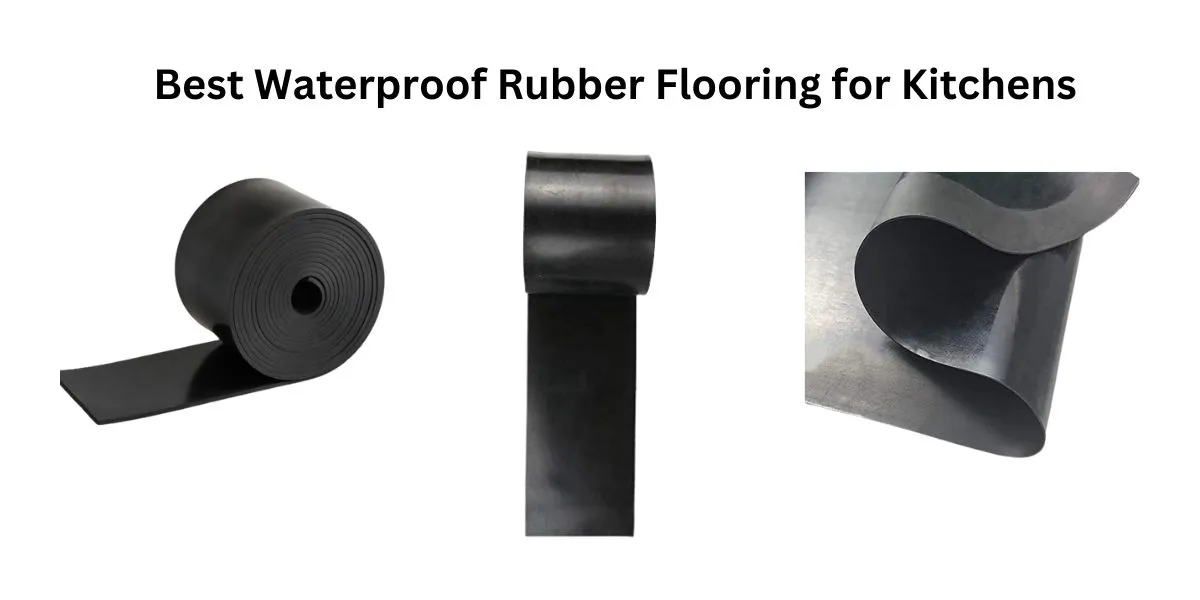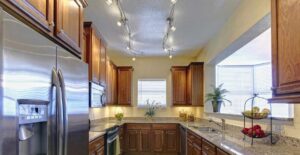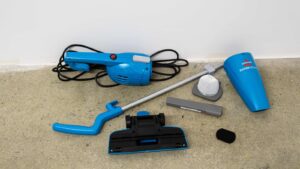The best waterproof rubber flooring for kitchens is a durable and slip-resistant option that provides excellent protection against water damage and spills. It is easy to clean and maintain, making it an ideal choice for busy kitchen environments.
Rubber flooring is a popular choice for kitchens due to its numerous benefits. It not only offers protection against water damage and spills but also provides a slip-resistant surface, ensuring safety in a potentially hazardous area. Moreover, rubber flooring is highly durable and long-lasting, making it an economical choice for homeowners.
With its ease of cleaning and maintenance, rubber flooring offers a hygienic solution for kitchens, preventing the growth of bacteria and fungi. In addition, its soft and cushioned texture provides comfort while standing for long periods, reducing fatigue. Overall, the best waterproof rubber flooring for kitchens combines practicality, safety, and durability, making it an excellent choice for any kitchen space.
Choosing Rubber Flooring For Kitchens
When it comes to finding the perfect flooring for your kitchen, durability, and practicality are key considerations. That’s where rubber flooring comes in. Not only is it an excellent choice for its waterproof nature, but it also offers a wide range of benefits that make it the ideal option for kitchen environments. In this article, we will explore the benefits of rubber flooring, and the various styles and textures available, as well as considerations for eco-friendliness and sustainability. So let’s dive in!
Benefits Of Using Rubber In Kitchen Environments
Using rubber flooring in kitchens provides a multitude of benefits that go beyond just being waterproof. Let’s take a closer look at these advantages:
- 1. Slip resistance: Rubber flooring offers excellent traction, making it perfect for kitchen areas where spills are common. This slip resistance not only ensures safety but also provides peace of mind as you move around the kitchen.
- 2. Durability: Rubber is known for its durability and resilience. It can withstand heavy foot traffic, the dropping of utensils, and even the occasional impact of heavy kitchen appliances. This longevity makes it a cost-effective option in the long run.
- 3. Sound insulation: If you have an open-plan kitchen, rubber flooring can help minimize noise transmission. Its inherent acoustic properties absorb sound, ensuring a quieter and more peaceful environment.
- 4. Easy maintenance: Rubber floors are effortless to clean and maintain. Regular sweeping or vacuuming, combined with occasional mopping using mild soap and water, is all that’s needed to keep your kitchen floor looking pristine.
- 5. Comfort underfoot: Standing for long periods in the kitchen can be tiring, but rubber flooring offers a cushioned surface that reduces strain on your feet and joints. This added comfort is especially beneficial for those who enjoy cooking or baking for extended periods.
Styles And Textures Available For Rubber Flooring
When it comes to rubber flooring, there is no shortage of options in terms of styles and textures. From sleek and modern to traditional and rustic, you can find a rubber flooring design that suits your kitchen aesthetic. Here are a few popular choices:
| Style/Texture | Description |
|---|---|
| Smooth | A smooth, seamless, and sleek surface that is easy to clean and maintain. |
| Textured | A textured surface that offers enhanced slip resistance and a visually interesting look. |
| Tile or plank | Designed to mimic the appearance of ceramic tiles or wooden planks, offering a versatile and stylish option for a kitchen floor. |
These are just a few examples of the styles and textures available in rubber flooring for kitchens. Whether you prefer a minimalist design or something more eye-catching, there will be an option that suits your taste.
Considerations For Eco-friendliness And Sustainability
In addition to being a practical and versatile choice, rubber flooring can also be an eco-friendly and sustainable option for your kitchen. Consider the following factors when selecting a rubber flooring product:
- Recycled content: Look for rubber flooring made from recycled materials, reducing the demand for virgin resources and contributing to a circular economy.
- Low VOC emissions: Choose rubber flooring products that have low volatile organic compound (VOC) emissions, ensuring better indoor air quality and a healthier living environment.
- Renewable resources: Some rubber flooring options are made from natural rubber derived from sustainable sources, further minimizing environmental impact.
- Life cycle assessment: Consider the overall life cycle of the product, including its manufacturing process, maintenance requirements, and eventual disposal. Opting for rubber flooring with a lower environmental footprint can contribute to sustainability efforts.
By taking these eco-friendly considerations into account, you can have a kitchen that not only looks great but also aligns with your values of sustainability and environmental responsibility.
Kitchen-specific Flooring Challenges
Looking for the best waterproof rubber flooring for kitchens? Overcome the challenges of kitchen-specific flooring with our durable and water-resistant rubber flooring options.
Resistance To Spills And Moisture
One of the biggest challenges when it comes to choosing the right flooring for your kitchen is the constant exposure to spills and moisture. From accidental spills of liquids to the humidity generated by cooking, the kitchen floor takes a beating daily. That’s why you need waterproof rubber flooring that can withstand these challenges with ease.
With its inherently water-resistant properties, rubber flooring emerges as an excellent choice for kitchens. The dense composition of rubber makes it naturally impermeable to liquids, preventing any moisture from seeping through the surface and causing damage. So, whether you spill a glass of water or accidentally drop a saucepan full of hot stew, a rubber floor will keep your kitchen protected.
Durability Under Kitchen Conditions
A kitchen is a busy place, and the flooring needs to be able to handle the constant foot traffic, dropped utensils, and heavy appliances. Rubber flooring proves to be exceptionally durable under these tough kitchen conditions.
Rubber is known for its strength and resilience, making it ideal for withstanding heavy loads and impacts. Whether you’re moving around furniture or dropping pots and pans, you can rest assured that your rubber flooring will remain intact. Its sturdy construction ensures it can last for years without showing signs of wear and tear.
Ease Of Cleaning And Maintenance
In a busy kitchen, cleanliness is of utmost importance. You need a flooring material that is easy to clean and maintain to ensure a hygienic environment. Rubber flooring delivers on this aspect as well.
Unlike other flooring options that require special cleaning agents or techniques, rubber flooring can be easily cleaned with just water and mild soap. Its smooth and non-porous surface prevents spills and stains from becoming deeply ingrained, making it a breeze to wipe them away. Additionally, its resistance to chemical damage ensures that cleaning agents won’t harm the flooring.
Another advantage of rubber flooring is its low maintenance requirements. It doesn’t require sealing or waxing like other flooring materials, saving you time and effort in the long run. A simple sweep or mop regularly is enough to keep your rubber kitchen floor looking clean and fresh.
Best Waterproof Rubber Flooring Options
When it comes to finding the best waterproof flooring for your kitchen, rubber is an excellent option to consider. With its durability, slip resistance, and water-resistant properties, rubber flooring is ideal for kitchens where spills and moisture are common. In this article, we will discuss the best waterproof rubber flooring options available, including a comparison of top waterproof rubber materials, brand comparisons, consumer reviews, and customization options for personal preferences.
Comparison Of Top Waterproof Rubber Materials
When selecting the best waterproof rubber flooring, it’s important to consider the different materials available. Here are some of the top waterproof rubber materials worth considering:
- EPDM Rubber: EPDM rubber is a popular waterproof flooring material known for its excellent durability and resistance to water, chemicals, and UV rays. It is easy to maintain and offers great slip resistance.
- Nitrile Rubber: Nitrile rubber is another excellent choice for waterproof flooring. It is resistant to oil, grease, water, and chemicals, making it perfect for kitchen environments. Nitrile rubber also provides superior slip resistance.
- Recycled Rubber: If you are looking for an eco-friendly option, recycled rubber flooring is a great choice. It is made from recycled materials and offers waterproof properties along with durability and slip resistance.
Brand Comparisons And Consumer Reviews
When investing in waterproof rubber flooring for your kitchen, it’s essential to consider different brands and consumer reviews. Here are some top brands known for their quality rubber flooring:
| Brand | Features | Reviews |
|---|---|---|
| NABOWAN | Durable, slip-resistant, easy to clean | 4.5/5 – Consumers love the durability and easy maintenance of Brand A’s rubber flooring. It provides excellent grip and stands up well to kitchen spills. |
| U-Turn Fasteners | Chemical-resistant, anti-fatigue properties | 4/5 – Customers appreciate the chemical resistance and anti-fatigue properties of Brand B’s rubber flooring. Some mentioned the installation process is a bit challenging. |
Park-It | Wide range of colors, customizable options | 5/5 – Users were impressed with Brand C’s extensive color options and customization choices, allowing them to match their kitchen decor perfectly. |
Customization Options For Personal Preferences
One of the advantages of rubber flooring is its versatility in customization. Here are some options for tailoring your rubber flooring to your personal preferences:
- Color choices: Many brands offer a wide range of colors, allowing you to select a shade that complements your kitchen’s aesthetic.
- Pattern selection: Some rubber flooring options come with various patterns, from simple designs to intricate motifs, giving you the freedom to choose a style that matches your taste.
- Thickness options: Different thicknesses provide various levels of comfort and cushioning. Consider your preferences and kitchen requirements when selecting the appropriate thickness for your rubber flooring.
Installation And Maintenance Tips
When it comes to choosing the best waterproof rubber flooring for kitchens, it’s essential to consider not only the quality of the material but also how it is installed and maintained. Proper installation and maintenance ensure the longevity and functionality of your rubber flooring. In this section, we will discuss the best practices for installing and maintaining rubber floors, as well as common pitfalls to avoid during installation.
Installing Your Rubber Flooring For Long-term Use
Proper installation of your rubber flooring sets the foundation for its long-term use. Follow these best practices:
- Prepare the subfloor: Ensure that the subfloor is clean, dry, and free of any debris or uneven surfaces. It will help create a smooth and secure base for the rubber flooring.
- Acclimate the rubber flooring: Let the rubber flooring acclimate in the room where it will be installed for at least 24 hours. This process allows the material to adjust to the temperature and humidity levels of the surroundings, minimizing the risk of expansion or contraction after installation.
- Use proper adhesive: Choose a high-quality adhesive suitable for rubber flooring. Follow the manufacturer’s recommendations for the specific type of rubber flooring you have selected. Applying the adhesive evenly and in the right amount ensures a secure bond between the rubber and the subfloor.
- Roll out and press the rubber flooring: Roll out the rubber flooring carefully, ensuring proper alignment with the room’s dimensions. Use a heavy roller to press the flooring firmly onto the adhesive, removing any air bubbles or wrinkles.
- Trim edges for a clean finish: After the adhesive has been set, trim any excess rubber along the edges of the room. This step provides a neat and professional-looking finish to your rubber flooring installation.
Best Practices In Maintaining Rubber Floors
Maintaining your rubber flooring is crucial for preserving its appearance and durability over time. Follow these best practices:
- Clean regularly: Regularly sweep or vacuum your rubber flooring to remove dust and debris. Use a neutral pH cleaner or a mild detergent with warm water for deeper cleaning. Avoid using harsh chemicals or abrasive cleaning tools that may damage the rubber surface.
- Immediately wipe spills: Accidental spills should be promptly wiped with a damp cloth or mop. Prompt action prevents potential staining or damage to the rubber surface.
- Protect against heavy furniture: Place furniture pads or protective mats underneath heavy objects to avoid indents or scratches on the rubber flooring. This practice distributes the weight more evenly and minimizes the risk of permanent damage.
- Avoid high heels and sharp objects: Discourage walking on the rubber flooring with high heels or dragging sharp objects, as these can cause cuts or punctures. If necessary, use protective mats or rugs in areas prone to such activities.
- Regular inspections: Periodically inspect your rubber flooring for any signs of wear, tear, or damage. Address any issues promptly to prevent further deterioration and maintain the integrity of the flooring.
Common Pitfalls To Avoid During Installation
When installing rubber flooring in your kitchen, avoid these common pitfalls to ensure a successful installation:
| Pitfall | Why to avoid |
|---|---|
| Insufficient subfloor preparation | Poor subfloor preparation can lead to uneven surfaces, compromising the adhesive bond and causing premature wear and tear. |
| Improper adhesive selection | Using the wrong adhesive can result in weak bonding or even flooring failure. Always select an adhesive that is specifically designed for rubber flooring. |
| Skipping the acclimation process | Acclimation allows the rubber flooring to adjust to the surrounding environment. Skipping this step can cause expansion, contraction, and unevenness after installation. |
| Inadequate adhesive application | Applying too little or too much adhesive can compromise the bond between the rubber flooring and the subfloor, leading to installation failures. |
| Neglecting seam sealing | Failing to seal seams properly can result in water penetration, causing damage to the subfloor and compromising the integrity of the rubber flooring. |
By following the installation best practices, maintaining your rubber floors diligently, and avoiding common pitfalls, you can enjoy beautiful and functional kitchen flooring that withstands the test of time.
Design Aesthetics With Rubber Flooring
Designing a kitchen involves careful consideration of various elements that can enhance both the functionality and aesthetics of the space. One such element that can greatly contribute to the overall design of your kitchen is the choice of flooring. While there are numerous options available, rubber flooring stands out as an excellent choice due to its durability, water resistance, and versatile design possibilities. Incorporating rubber flooring into your kitchen design opens up a whole new world of design aesthetics that can elevate the look and feel of your space.
Incorporating Rubber Flooring Into Your Kitchen Design
When it comes to designing your kitchen, rubber flooring offers unique advantages that other flooring options may not provide. Its inherent water resistance makes it an ideal choice for kitchens where spills and moisture are common occurrences. Not only does it prevent water damage, but it is also easy to clean and maintain. Additionally, rubber flooring is available in a variety of patterns and finishes, allowing you to fully customize your kitchen design. Whether you prefer a sleek and modern look or a warm and rustic aesthetic, rubber flooring can effortlessly adapt to your desired style.
Color Choices And Matching With Kitchen Cabinets
Color plays a vital role in creating the ambiance of your kitchen. With rubber flooring, you have a wide range of color choices to match your kitchen cabinets and complement your existing décor. From classic shades of black, gray, and white to vibrant hues of red, blue, or green, rubber flooring offers endless possibilities for creating a cohesive design. Ensure that the colors of your rubber flooring and kitchen cabinets harmonize well, creating a visually pleasing and cohesive look.
Creating A Seamless Look With Your Existing Décor
One of the advantages of rubber flooring is its ability to seamlessly integrate with your existing décor. Whether you have a modern, traditional, or eclectic kitchen design, rubber flooring can effortlessly blend in and enhance the overall aesthetic. Its versatile nature allows you to maintain a consistent look throughout your space, ensuring that every element complements one another. By choosing a pattern, texture, and color that resonates with your existing décor, you can create a harmonious and visually appealing kitchen atmosphere.
Design aesthetics play a crucial role in shaping the overall look and feel of your kitchen. With rubber flooring, you can achieve both functionality and style without compromising on either. Incorporate rubber flooring into your kitchen design, select colors that complement your cabinets, and create a seamless look with your existing décor. With the versatility and durability of rubber flooring, your kitchen will undoubtedly become a space that not only serves its purpose but also reflects your style.
Budget Considerations For Kitchen Flooring
Discover the best budget-friendly waterproof rubber flooring options for kitchens, offering both practicality and style. These durable and easy-to-maintain choices ensure your kitchen floors stay protected without breaking the bank.
Cost Analysis Of Rubber Flooring Solutions
When it comes to choosing the best waterproof rubber flooring for your kitchen, budget considerations play a significant role. Rubber flooring is a fantastic option for kitchens due to its durability, easy maintenance, and water-resistant properties. However, before you make a purchase, it’s important to analyze the costs involved. Let’s dive into the cost analysis of various rubber flooring solutions available in the market.
Comparing Long-term Value Against Other Materials
While rubber flooring may have a higher upfront cost compared to other kitchen flooring options, it is essential to consider the long-term value it offers. Unlike traditional materials like hardwood or laminate, rubber flooring is known for its outstanding durability, which means it can last significantly longer. By investing in high-quality rubber flooring, you can save money on repairs and replacements, making it a cost-effective and value-efficient choice for your kitchen.
Finding The Best Deals Without Compromising Quality
When it comes to finding the best deals on rubber flooring without compromising quality, a little research can go a long way. Look for reputable suppliers who offer competitive prices. Additionally, keep an eye out for discounts, promotions, and sales events. Compare prices from different suppliers and consider the quality of the rubber flooring they offer. Remember, it’s always better to invest in a slightly higher-priced, high-quality product that will provide long-lasting performance rather than compromising on durability and functionality for a lower price.
Furthermore, timing your purchase can also help you score the best deals. Keep an eye out for seasonal or clearance sales in your area, as retailers often offer significant discounts during these periods. By conducting thorough research and comparing prices, you can find the best deals on waterproof rubber flooring for your kitchen while ensuring top-notch quality for your investment.
In conclusion, budget considerations are crucial when selecting the best waterproof rubber flooring for your kitchen. By analyzing the cost, comparing a long-term value against other materials, and finding the best deals without compromising quality, you can make an informed decision that combines affordability with durability. So, take your time, do your research, and find the perfect rubber flooring solution that meets both your budget and kitchen flooring needs.
Frequently Asked Questions On Best Waterproof Rubber Flooring For Kitchens
Can Rubber Flooring Be Used In Kitchens?
Yes, rubber flooring is an excellent choice for kitchens. It is water resistant, durable, easy to clean, and provides a non-slip surface for safety.
Is Rubber Flooring Waterproof?
Yes, rubber flooring is waterproof and perfect for areas prone to moisture, such as kitchens. It creates a protective barrier that prevents water from penetrating the surface, keeping your floors dry and damage-free.
What Are The Benefits Of Rubber Flooring For Kitchens?
Rubber flooring offers several benefits for kitchens. It is slip-resistant, comfortable to stand on for long periods, and absorbs noise. Additionally, it is easy to maintain, hygienic, and environmentally friendly.
How Do I Clean Rubber Flooring In My Kitchen?
Cleaning rubber flooring in your kitchen is simple. Sweep or vacuum to remove dirt and debris, then mop with a mild soap and water solution. Avoid abrasive cleaners and excessive moisture, as they may damage the rubber.
Conclusion
Choosing the best waterproof rubber flooring for your kitchen is essential for its durability and functionality. It provides a seamless and watertight surface that can withstand spills, stains, and moisture. With its slip-resistant properties and easy maintenance, it is the perfect choice for a high-traffic area like the kitchen.
Invest in quality rubber flooring to enjoy a long-lasting and hassle-free kitchen flooring solution.





